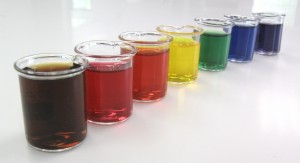Rae really wants to know…Hi, in your blog you talked about the 1% line. I’m not a cosmetic chemist and I kind of always wondered how to guestimate where the 1% line is. So my question is, if you’re not a cosmetic chemist, what’s a good guide to know more or less the ratio of an ingredient to the whole product?
The Beauty Brains respond
This is a really tricky question because there is no single answer that covers all products. But we can give you a very rough, general rule of thumb to follow.
Ingredients in cosmetics
The vast majority of cosmetic products are water based. These include emulsion products (oils mixed with water) like skin lotions and hair conditioners as well as surfactant products (detergents mixed with water) like body washes, shampoos and facial washes. In these product water, of course, will almost always be the first ingredient in the list. After that, the next 4 or 5 ingredients are usually the ones responsible for the primary functional properties of the product – in other words they are the cleansers that make it foam or the conditioners that make your hair and skin feel soft. The same principle applies to powder based products (like eyeshadow, foundation, and baby powder) as well as solvent based products (like water-free hairsprays and silicone shine sprays.) So the magic rule of thumb is the first 5 ingredients are the ones that matter the most. After the fifth ingredient everything else is probably below the 1% line. This is where a lot of “snake oil” ingredients hide.
The 1%
Now, before you start an “Occupy Cosmetics” movement to complain about the 1%, let me point out that this doesn’t mean that none of the ingredients below the 1% line matter. For example, certain active ingredients (like retinol for skin) are used at levels below 1%. Pigments are always used at very low levels yet they are critically important to color cosmetics. And preservatives are only used at a few tenths of percent, yet I wouldn’t want to buy a product without them! There are many exceptions to this “First Five” rule.
The Beauty Brains bottom line
This rule of thumb is about the best guideline we can give to help you guestimate the level of ingredients in cosmetics. But that’s just our humble opinion: If there are any other cosmetic scientists reading this post we’d love to hear if you have a different perspective. And if anyone has a question about a specific ingredient in a particular product, we’d be glad to help answer any questions. Just leave a comment on this post or start a thread our Forum.
